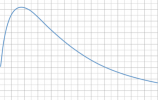I feel there are too many outside factors that affect flight (more than speed) that can more greatly affect RTH outcomes.
The biggest one is simply proactive pre flight checks and avoiding low battery problems in the first place.
When you know good drone flight procedures, you simply are almost totally unlikely to ever find yourself in this sort of bother.
- Flying out with the wind and returning with it.
- Aiming for landing at ~ 20% battery is good for both safety and battery longevity.
- Knowing what the wind is doing and RTH either set to as low an altitude as practical, or bringing it down to such a level asap as the drone returns.
- Knowing when RTH or normal flight speed simply isn't getting you where you need to be for drone movement.
If you push the envelope on battery often, risky flights way out over ocean / high wind etc, or simply want to know this for such scenarios, then proceed with your individual testing, so you can be somewhat prepared for best battery power use.
I would certainly also practice the manual 'headway making' tasks above too, and get used to looking for a clearings / flat landing areas etc in otherwise hostile terrain for emergency landings etc.
Being prepared can certainly help reduce the panic type behaviours often seen when something unusual happens in flight.













